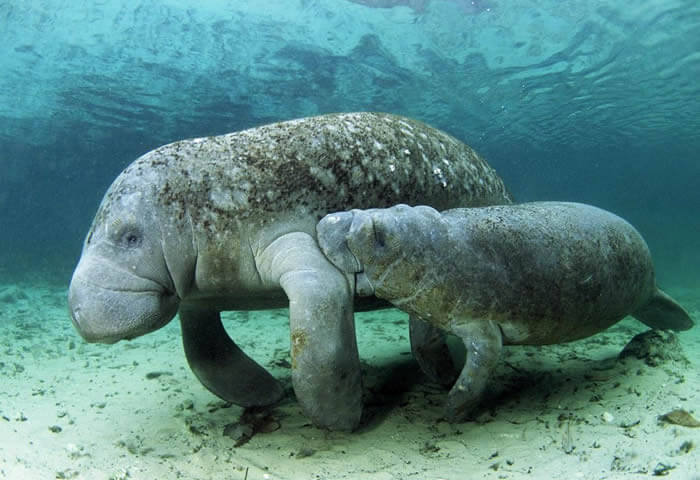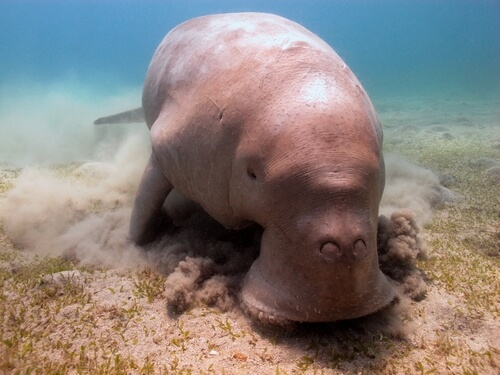Find Out All About the Dugong!

The dugong is a curious marine mammal that bears a certain physical similarity to seals. The only difference is that it has a wider body that reminds us more of manatees. Despite their appearance, these large animals are known to be quite docile in nature.
The scientific name of this species is Dugong dugon. It’s the only living member of the Dugongidae family, which also included the now-extinct Steller’s sea cow. Continue reading this space and learn more about the peculiar dugong.
Habitat and distribution
This species has a preference for inhabiting tropical and subtropical coastal areas, so its distribution is wide and extends from East Africa to Australia. Of course, due to various problems of overexploitation, its population has been drastically reduced and it’s currently difficult to find.
Most specimens tend to concentrate in deep water areas such as bays and deep mangrove channels. These areas are characterized by a high density of plants, which are fundamental to the life of the dugong.

Physical characteristics of the dugong
The body of the dugong is quite similar to that of a manatee, with an oval and fusiform appearance, which can reach 3 meters (around 10 feet) in length and weigh 200 kilograms (440 pounds). It has two pectoral fins, in addition to a tail similar to that observed in cetaceans. As if that weren’t enough, its head is oval and its mouth opens in the direction of the belly, which is essential for them, as this is how they obtain their food.
As for their teeth, dugongs don’t have any normal ones. However, they use a type of hardened plate (corneas) to grind their food. Also, males sport a pair of exposed incisors that closely resemble those of elephants.
Behavior
One of the most identifiable traits of this animal is its peculiarly peaceful and sociable behavior. In most cases, they’re usually found alone or in pairs, as, otherwise, their habitat isn’t able to provide food for all of them. Of course, this doesn’t mean that it’s impossible to see them in herds or groups, but this only happens temporarily, and for a short time.
Although the dugong spends most of its life near the surface (10 meters – 33 feet – deep), it’s capable of reaching 39 meters deep (127 feet). This restriction may be due to the fact that it doesn’t resist long without air (maximum 6 minutes). Moreover, in some cases they stay upright with their tails on the bottom and their head on the surface, so they can rest and breathe at the same time.
Feeding
The dugong’s diet is herbivorous, which means that it only consumes plants, roots and leaves found in the ocean. Because of this, it’s also known as the sea cow, since its peculiar mouth allows it to graze on sandy bottoms in search of sea grasses.
In fact, some specialists tell us that the dugong eats very carefully in order to encourage the growth of marine vegetation. In this way, it ensures that its food regenerates and it doesn’t run out of resources in the future. This strategy is known as grazing.
Dugong reproduction
The female dugong reaches sexual maturity at 17 years of age, so the reproductive success of the species is quite restricted. They don’t seem to have a specific mating season, but it has been detected that most offspring are born between July and September.
On the other hand, the gestation process lasts between 13 and 15 months. Each female usually gives birth to only one calf, so that she’s fully dedicated to ensuring its survival. Consequently, the nursing and maternal care process can last between 14 and 18 months, although this time may vary according to the population.

Why is it endangered?
Although this animal has a stocky body, it lacks defensive skills against its enemies. In addition, they’re unable to move fast, so they’re easy prey for larger and more powerful animals such as sharks or killer whales. Although this shouldn’t endanger their population, these traits make them a victim of overexploitation by humans.
Both the meat and fat of this animal are very popular in the markets near the Indian Ocean. Because of this, they have been pursued to supply the local demand for this curious ingredient. As if that weren’t enough, different fishing vessels using trawl nets also often accidentally catch the dugong. All in all, this is what has reduced its population far too much.
As you can see, the dugong is a peculiar marine mammal that isn’t capable of harming anyone. However, human greed has driven it almost to extinction. At present, the species is listed as vulnerable by the International Union for Conservation of Nature.
All cited sources were thoroughly reviewed by our team to ensure their quality, reliability, currency, and validity. The bibliography of this article was considered reliable and of academic or scientific accuracy.
- Hagihara, R., Jones, R. E., Sobtzick, S., Cleguer, C., Garrigue, C., & Marsh, H. (2018). Compensating for geographic variation in detection probability with water depth improves abundance estimates of coastal marine megafauna. PloS One, 13(1), 1-15. https://journals.plos.org/plosone/article?id=10.1371/journal.pone.0191476
- McDonald, M. (2011). Dugong dugon. Animal Diversity. https://animaldiversity.org/accounts/Dugong_dugon/
- Rajamani, L., Cabanban, A. S., & Rahman, R. A. (2006). Indigenous use and trade of dugong (dugong dugon) in Sabah, Malaysia. AMBIO: A Journal of the Human Environment, 35(5), 266–268.https://bioone.org/journals/ambio-a-journal-of-the-human-environment/volume-35/issue-5/05-S-093.1/Indigenous-Use-and-Trade-of-Dugong-Dugong-dugon-in-Sabah/10.1579/05-S-093.1.short
- Preen, A. (1995). Impacts of dugong foraging on seagrass habitats: observational and experimental evidence for cultivation grazing. Marine Ecology Progress Series, 124, 201–213. https://www.int-res.com/abstracts/meps/v124/p201-213/
- O’Shea, T. (19 de octubre 2023). Dugong. Enciclopedia Britannica. https://www.britannica.com/animal/dugong-mammal
- Seagrass-Watch Global Seagrass Observing Network. (s. f.). Dugons. Consultado el 28 de noviembre de 2023. https://www.seagrasswatch.org/dugong/
- The Dugong and Seagrass Conservation Project. (s. f.). About Dugong & Seagrass. Consultado el 28 de noviembre de 2023. https://www.dugongconservation.org/about/about-dugongs-seagrass/
